RGB stands for the three additive primary colors red, green and blue. Thru additive color mixing, all colors of the RGB-Model can be produced. Monitors and televisions use the RGB-Model to show colors. Each primary color has a value between 0 and 1. R=G=B=1 equals white, R=G=B=0 equals black.
All RGB colors can be shown in a cube. The three primary colors, the three secondary colors (cyan, magenta, yellow) as well as white and black are positioned in the corners of the RGB-cube.
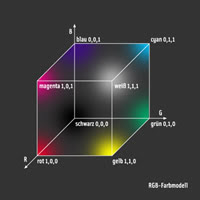
HSV Model
Downside of the RGB model is the difficulty to mix colors. It is not easy to find the right amount of red, green and blue to mix a specific color tone. Mixing colors using the HSV model (hue, saturation, value) is much more intuitive because there is a separate value for the hue.
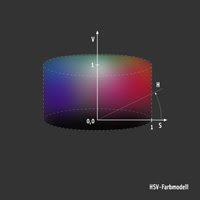
CMY(K) Model
Displaying colors on a screen is based on the RGB model (additive), whereas printing colors on paper is based on the subtractive CMY(K) model. CMY(K) stands for cyan, magenta, yellow and black. Similar to the RGB model, all CMY model can be displayed in a cube.
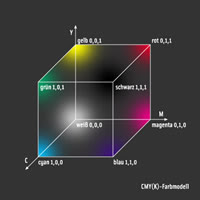
CIE Model
The CIE model was defined by the "Commision International de l'Eclairage" in 1931. The three additive primary colors red green and blue are replaced by the standardized primary colors X,Y,Z. The XYZ color space comprises all visible colors. XYZ are virtual colors that are used to display all visible colors with positive algebraic signs. The spectral consistence correlates to the color perception of the human eye: The value of XYZ is proportional to the physical energy of the represented color.
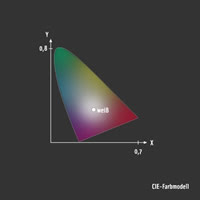
CIE L*a*b Model
The CIE L*a*b model is a common color space, redefined from the original CIE model in 1976. It is based on the human perception of color which is based on the three color receptors of the human eye (red, green, blue). L is the value for the luminance of an object (L = 0 = black, L = 100 = white). The chrominance is defined by the a and b values. The a value stands for red (a is positive) or green (a is negative). The b value stands for yellow (b is positive) or blue (b is negative). The higher the a and b values, the more saturated the color.
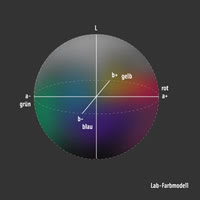
YIQ Model
YIQ is used in color TV broadcasting. It is downward compatible with black and white television where only Y is used. Y stands for the luminance (intensity). I and Q determine the chromaticity. I is the red-orange axis, where
 as Q is roughly orthogonal to I.
as Q is roughly orthogonal to I.
No comments:
Post a Comment